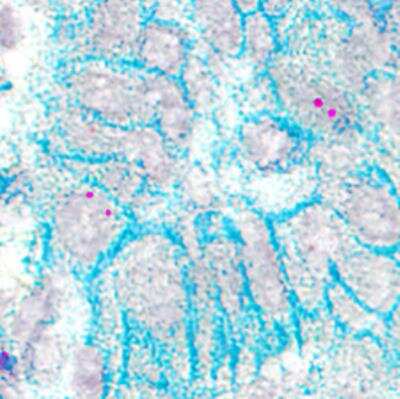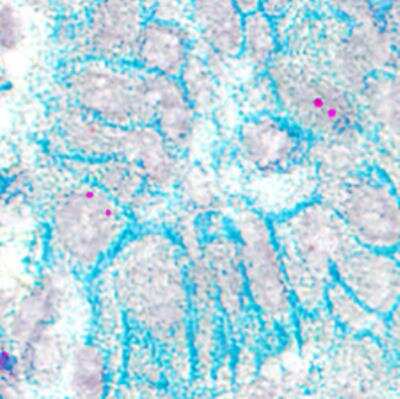CD4 Antibody - BSA Free
Novus Biologicals, part of Bio-Techne | Catalog # NBP1-19371

![Immunohistochemistry: CD4 Antibody - BSA Free [NBP1-19371] Immunohistochemistry: CD4 Antibody - BSA Free [NBP1-19371]](https://resources.bio-techne.com/images/products/CD4-Antibody-Immunohistochemistry-NBP1-19371-img0017.jpg)
Conjugate
Catalog #
Key Product Details
Species Reactivity
Validated:
Human, Mouse, Rat, Porcine, Canine, Rabbit
Cited:
Human, Mouse, Rat, Porcine, Canine, Flow, Rabbit
Applications
Validated:
Dual RNAscope ISH-IHC, Flow Cytometry, Immunocytochemistry/ Immunofluorescence, Immunohistochemistry, Immunohistochemistry-Frozen, Immunohistochemistry-Paraffin, Simple Western, Western Blot
Cited:
IF/IHC, Immunocytochemistry/ Immunofluorescence, Immunohistochemistry-Frozen, Immunohistochemistry-Paraffin, Rabbit, Western Blot
Label
Unconjugated
Antibody Source
Polyclonal Rabbit IgG
Format
BSA Free
Concentration
1.0 mg/ml
Product Specifications
Immunogen
A synthetic peptide made to an C-terminal region of the human CD4 Antibody protein (within residues 400-458). [Swiss-Prot P01730]
Reactivity Notes
Rabbit reactivity reported in the scientific literature (PMID: 22127304). Customer feedback positive on canine. Use in Porcine reported in scientific literature (PMID:33839961)
Localization
Membrane
Clonality
Polyclonal
Host
Rabbit
Isotype
IgG
Scientific Data Images for CD4 Antibody - BSA Free
Immunohistochemistry: CD4 Antibody - BSA Free [NBP1-19371]
Immunohistochemistry: CD4 Antibody [NBP1-19371] - Increased CD3+ and CD4+ T-cell occurrence in the brainstem of SHR-72 transgenic rat model for tauopathies. (A-D) Immunofluorescence staining showed CD4+ T-cells in SHR-72 transgenic animals. (E- H) Immunofluorescence staining showed more perivascular than brain parenchyma infiltrating CD4+ T-cells in SHR-72 transgenic animals. PLoS One. 2019 May 23;14(5):e0217216. doi: 10.1371/journal.pone.0217216.Immunohistochemistry: CD4 Antibody - BSA Free [NBP1-19371]
Immunohistochemistry: CD4 Antibody [NBP1-19371] - DBZ inhibits the accumulation of CD4+ T cells and Th2 differentiation in the AAAs. (B) The representation of immunohistochemical staining for CD4+ in abdominal aorta from four groups (left). Bar graphs show the percentage of CD4+ positive cell areas (right; n=3 per group). Bar: 50 um.Western Blot: CD4 AntibodyBSA Free [NBP1-19371]
Western Blot: CD4 Antibody [NBP1-19371] - CD4 antibody was tested in the following cell lysates: 1) human spleen 2) human tonsil 3) human placenta 4) human kidney 5) human liver 6) mouse spleen 7) mouse placenta 8) rat placenta.Applications for CD4 Antibody - BSA Free
Application
Recommended Usage
Flow Cytometry
5 ug/ml
Immunocytochemistry/ Immunofluorescence
1:50-1:200
Immunohistochemistry
1:50-1:500
Immunohistochemistry-Paraffin
1:50-1:500
Simple Western
1:100
Western Blot
1 ug/ml
Application Notes
This CD4 antibody is useful for ICC, Western Blot, and IHC-paraffin embedded sections. In WB, a band is seen ~45 kDa. In ICC/IF, membrane staining was observed in human brain cells. Prior to immunostaining paraffin tissues, antigen retrieval with sodium citrate buffer (pH 6.0) is recommended. In ICC/IF, membrane staining was observed in Jurkat cells.
In Simple Western only 10 - 15 uL of the recommended dilution is used per data point.
See Simple Western Antibody Database for Simple Western validation: Tested in HeLa lysate 0.5 mg/mL, separated by Size, antibody dilution of 1:100. Separated by Size-Wes, Sally Sue/Peggy Sue.
In Simple Western only 10 - 15 uL of the recommended dilution is used per data point.
See Simple Western Antibody Database for Simple Western validation: Tested in HeLa lysate 0.5 mg/mL, separated by Size, antibody dilution of 1:100. Separated by Size-Wes, Sally Sue/Peggy Sue.
Reviewed Applications
Read 9 reviews rated 4.1 using NBP1-19371 in the following applications:
Formulation, Preparation, and Storage
Purification
Immunogen affinity purified
Formulation
PBS
Format
BSA Free
Preservative
0.02% Sodium Azide
Concentration
1.0 mg/ml
Shipping
The product is shipped with polar packs. Upon receipt, store it immediately at the temperature recommended below.
Stability & Storage
Store at 4C short term. Aliquot and store at -20C long term. Avoid freeze-thaw cycles.
Background: CD4
Given its critical role in T cell development, CD4 also has diverse immunology-related functions. CD4 acts as a coreceptor with the T-cell receptor (TCR) during T cell activation and thymic differentiation by binding directly to major histocompatibility complex (MHC) class II antigens and associating with the protein tyrosine kinase, Lck (4). This interaction contributes to the formation of the immunological synapse (5). Defects in antigen presentation cause dysfunction of CD4+ T cells and the almost complete loss of MHC II expression on B cells in peripheral blood, as observed in severe combined immunodeficiency (SCID) (6). CD4 also functions as a receptor for the human immunodeficiency virus (HIV) by binding to gp120, the envelope glycoprotein of HIV-1. It has been shown that the V-like domains are critical for binding to gp120 (7). In immune mediated and infectious diseases of the central nervous system, CD4 functions as an indirect mediator of neuronal damage (8).
References
1. Omri, B., Crisanti, P., Alliot, F., Marty, M., Rutin, J., Levallois, C., . . . Pessac, B. (1994). CD4 expression in neurons of the central nervous system. International Immunology, 6(3), 377-385. doi:10.1093/intimm/6.3.377
2. Wan, Y. Y., & Flavell, R. A. (2009). How diverse-CD4 effector T cells and their functions. Journal of Molecular Cell Biology, 1(1), 20-36. doi:10.1093/jmcb/mjp001
3. Wu, H., Myszka, D. G., Tendian, S. W., Brouillette, C. G., Sweet, R. W., Chaiken, I. M., & Hendrickson, W. A. (1996). Kinetic and structural analysis of mutant CD4 receptors that are defective in HIV gp120 binding. Proceedings of the National Academy of Sciences, 93(26), 15030-15035. doi:10.1073/pnas.93.26.15030
4. Doyle, C., & Strominger, J. L. (1987). Interaction between CD4 and class II MHC molecules mediates cell adhesion. Nature, 330, 256-259. doi:10.1038/330256a0
5. Vignali, D. A. (2010). CD4 on the road to coreceptor status. The Journal of Immunology, 184(11), 5933-5934. doi:10.4049/jimmunol.1090037
6. Tasher, D., & Dalal, I. (2012). The genetic basis of severe combined immunodeficiency and its variants. The Application of Clinical Genetics, 5, 67-80. doi:10.2147/tacg.s18693
7. Arthos, J., Deen, K. C., Chaikin, M. A., Fornwald, J. A., Sathe, G., Sattentau, Q. J., . . . Sweet, R. W. (1989). Identification of the residues in human CD4 critical for the binding of HIV. Cell, 57(3), 469-481. doi:10.1016/0092-8674(89)90922-7
8. Buttini, M., Westland, C. E., Masliah, E., Yafeh, A. M., Wyss-Coray, T., Mucke, L. (1998). Novel role of human cd4 molecule identified in neurodegeneration. Nature Medicine, 4(4), 441-446. doi:10.1038/nm0498-441
Alternate Names
CD4
Gene Symbol
CD4
Additional CD4 Products
Product Documents for CD4 Antibody - BSA Free
Product Specific Notices for CD4 Antibody - BSA Free
This product is for research use only and is not approved for use in humans or in clinical diagnosis. Primary Antibodies are guaranteed for 1 year from date of receipt.
Loading...
Loading...
Loading...
Loading...
Loading...
Loading...
![Immunohistochemistry: CD4 Antibody - BSA Free [NBP1-19371] Immunohistochemistry: CD4 Antibody - BSA Free [NBP1-19371]](https://resources.bio-techne.com/images/products/CD4-Antibody-Immunohistochemistry-NBP1-19371-img0018.jpg)
![Western Blot: CD4 AntibodyBSA Free [NBP1-19371] Western Blot: CD4 AntibodyBSA Free [NBP1-19371]](https://resources.bio-techne.com/images/products/CD4-Antibody-Western-Blot-NBP1-19371-img0002.jpg)
![Immunocytochemistry/ Immunofluorescence: CD4 Antibody - BSA Free [NBP1-19371] Immunocytochemistry/ Immunofluorescence: CD4 Antibody - BSA Free [NBP1-19371]](https://resources.bio-techne.com/images/products/CD4-Antibody-Immunocytochemistry-Immunofluorescence-NBP1-19371-img0005.jpg)
![Flow Cytometry: CD4 Antibody - BSA Free [NBP1-19371] Flow Cytometry: CD4 Antibody - BSA Free [NBP1-19371]](https://resources.bio-techne.com/images/products/CD4-Antibody---BSA-Free-Flow-Cytometry-NBP1-19371-img0023.jpg)
![Western Blot: CD4 AntibodyBSA Free [NBP1-19371] Western Blot: CD4 AntibodyBSA Free [NBP1-19371]](https://resources.bio-techne.com/images/products/CD4-Antibody-Western-Blot-NBP1-19371-img0007.jpg)
![Immunohistochemistry-Paraffin: CD4 Antibody - BSA Free [NBP1-19371] Immunohistochemistry-Paraffin: CD4 Antibody - BSA Free [NBP1-19371]](https://resources.bio-techne.com/images/products/CD4-Antibody-Immunohistochemistry-Paraffin-NBP1-19371-img0006.jpg)
![Immunohistochemistry-Paraffin: CD4 Antibody - BSA Free [NBP1-19371] Immunohistochemistry-Paraffin: CD4 Antibody - BSA Free [NBP1-19371]](https://resources.bio-techne.com/images/products/CD4-Antibody-Immunohistochemistry-Paraffin-NBP1-19371-img0011.jpg)
![Immunohistochemistry-Paraffin: CD4 Antibody - BSA Free [NBP1-19371] Immunohistochemistry-Paraffin: CD4 Antibody - BSA Free [NBP1-19371]](https://resources.bio-techne.com/images/products/CD4-Antibody-Immunohistochemistry-Paraffin-NBP1-19371-img0012.jpg)
![Immunohistochemistry-Frozen: CD4 Antibody - BSA Free [NBP1-19371] Immunohistochemistry-Frozen: CD4 Antibody - BSA Free [NBP1-19371]](https://resources.bio-techne.com/images/products/CD4-Antibody-Immunohistochemistry-Frozen-NBP1-19371-img0013.jpg)
![Immunohistochemistry-Paraffin: CD4 Antibody - BSA Free [NBP1-19371] Immunohistochemistry-Paraffin: CD4 Antibody - BSA Free [NBP1-19371]](https://resources.bio-techne.com/images/products/CD4-Antibody-Immunohistochemistry-Paraffin-NBP1-19371-img0014.jpg)
![Flow Cytometry: CD4 Antibody - BSA Free [NBP1-19371] Flow Cytometry: CD4 Antibody - BSA Free [NBP1-19371]](https://resources.bio-techne.com/images/products/CD4-Antibody-Flow-Cytometry-NBP1-19371-img0015.jpg)
![Flow Cytometry: CD4 Antibody - BSA Free [NBP1-19371] Flow Cytometry: CD4 Antibody - BSA Free [NBP1-19371]](https://resources.bio-techne.com/images/products/CD4-Antibody-Flow-Cytometry-NBP1-19371-img0016.jpg)
![Flow Cytometry: CD4 Antibody - BSA Free [NBP1-19371] Flow Cytometry: CD4 Antibody - BSA Free [NBP1-19371]](https://resources.bio-techne.com/images/products/CD4-Antibody-Flow-Cytometry-NBP1-19371-img0021.jpg)
![Flow Cytometry: CD4 Antibody - BSA Free [NBP1-19371] Flow Cytometry: CD4 Antibody - BSA Free [NBP1-19371]](https://resources.bio-techne.com/images/products/CD4-Antibody-Flow-Cytometry-NBP1-19371-img0022.jpg)
![Simple Western: CD4 AntibodyBSA Free [NBP1-19371] Simple Western: CD4 AntibodyBSA Free [NBP1-19371]](https://resources.bio-techne.com/images/products/CD4-Antibody-Simple-Western-NBP1-19371-img0009.jpg)


![Western Blot: CD4 Antibody - BSA Free [NBP1-19371] - CD4 Antibody - BSA Free](https://resources.bio-techne.com/images/products/nbp1-19371_rabbit-polyclonal-cd4-antibody-23220248151443.jpg)
![Immunocytochemistry/ Immunofluorescence: CD4 Antibody - BSA Free [NBP1-19371] - CD4 Antibody - BSA Free](https://resources.bio-techne.com/images/products/nbp1-19371_rabbit-polyclonal-cd4-antibody-310202416163759.jpg)